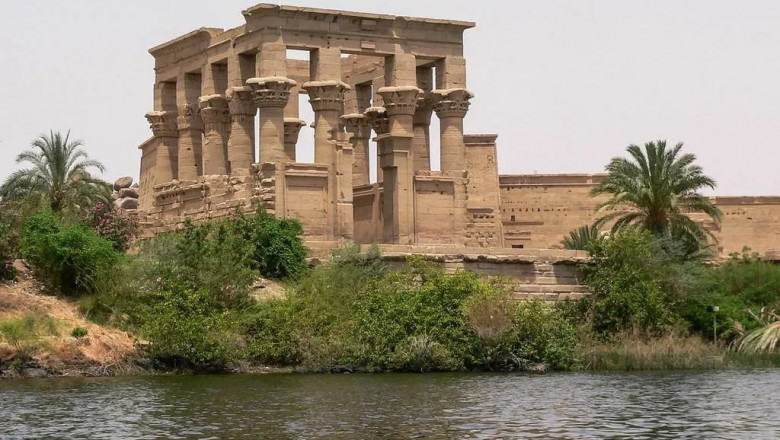views
Elephantine Island in Aswan, nestled in the heart of the Nile, is one of Egypt’s most historically rich and culturally significant sites. With origins dating back to antiquity, the island is more than just a scenic retreat—it’s a living museum where ancient ruins, enduring legends, and vibrant local life come together, offering a captivating glimpse into Egypt’s distant past.
The Origin of the Name
The name Elephantine is believed to derive either from the island’s resemblance to the shape of an elephant tusk or the island’s historical significance in the ivory trade. In ancient times, Elephantine was called “Abu,” meaning “elephant” in Egyptian. This name reflects its importance as a trade hub, particularly for goods such as ivory, gold, and exotic items brought from Nubia and Africa to the south.
A Strategic and Spiritual Center
Elephantine Island served as a military and commercial outpost throughout various dynasties. Positioned at the southern frontier of ancient Egypt, it guarded the border and functioned as a gateway between Egypt and Nubia. Its strategic importance made it a bustling center for military activity, trade, and religious ceremonies.
The island was also a religious center dedicated to the ram-headed god Khnum, the deity believed to be the creator of human bodies, who fashioned them on a potter’s wheel using Nile clay. Alongside Khnum, worship also extended to Satet (his consort) and Anuket (their daughter), forming a local triad. Their temple complex still exists in partial ruins and stands as one of the oldest on the island.
The Temple of Khnum
One of the island’s most significant structures is the Temple of Khnum, dating back to the Third Dynasty. Although much of it is in ruins today, sections were restored during the Ptolemaic period. The temple offers insights into the religious life and architectural brilliance of ancient Egypt. Visitors can view reconstructed columns, hieroglyphic inscriptions, and sacred spaces that once hosted rituals honoring Khnum and the Nile’s life-giving flood.
Interestingly, the island played a major role in monitoring the Nile’s inundation. A nilometer—still preserved today—was used to measure the water level of the river. This allowed priests and officials to predict agricultural success and plan accordingly. The Elephantine Nilometer, located within the temple precinct, is among the oldest known in Egypt and remains remarkably intact.
The Jewish Community and the Aramaic Papyri
Elephantine also hosted a diverse population. During the 5th century BCE, a Jewish garrison community lived on the island under Persian rule. Archaeologists discovered the Elephantine Papyri, a collection of Aramaic texts that shed light on the daily lives, religious practices, and legal dealings of this Jewish population. These documents are invaluable for understanding how diaspora communities adapted and coexisted with native Egyptians.
The papyri also reveal a rare instance of a Jewish temple being built outside Jerusalem during that era. Though this temple was eventually destroyed, the documents remain a rich source of social, religious, and political history.
The Ruins of Abu and Roman Influence
Beneath the surface of Elephantine Island lies Abu, the ancient town that once thrived with life and activity. Ongoing excavations continue to unearth multi-period layers of history—from Pharaonic and Persian to Roman and Islamic times.
Roman influence on the island is visible through various artifacts and architectural styles. While most structures from this period have eroded or were built over, Elephantine’s layers still tell stories of imperial transitions and cultural fusion.
The Aswan Museum
Located on the southeastern part of the island, the Aswan Museum was established in 1912 and provides an organized display of the island’s discoveries. The museum exhibits statues, pottery, tools, and everyday objects found during excavation, offering context to the ruins scattered across the island.
Outside the museum lies an open-air archaeological site with walls, columns, and ancient residences that further paint a vivid picture of life thousands of years ago.
Nubian Villages and Modern Life
Elephantine Island isn’t frozen in the past. It’s home to vibrant Nubian villages that preserve traditional customs, languages, and lifestyles. Painted houses, colorful textiles, and warm hospitality offer a living contrast to the stone ruins and archaeological sites nearby.
The coexistence of ancient and modern life gives Elephantine Island its unique rhythm—a peaceful blend of history, culture, and community. Visitors often find themselves equally fascinated by the locals’ stories as by the island’s monuments.
How to Visit
Accessible only by felucca (traditional wooden sailboats) or motorboats, the journey to Elephantine Island is as memorable as the destination. The ride offers a panoramic view of the Nile and Aswan’s scenic beauty, especially at sunset. Entrance fees to specific sites like the Temple of Khnum or the Aswan Museum may apply, and guided tours are recommended for deeper historical insight.
Final Thoughts
Elephantine Island in Aswan stands as a testament to Egypt’s layered history—an open-air archive where ancient beliefs, trade networks, and multicultural communities intersect. It offers not just ruins, but stories. Not just temples, but testaments to the endurance of civilizations.
Whether you’re an archaeology enthusiast, a history buff, or a curious traveler, Elephantine Island invites you to uncover its ancient wonders and experience a lesser-known yet deeply significant chapter of Egypt’s past.














Comments
0 comment